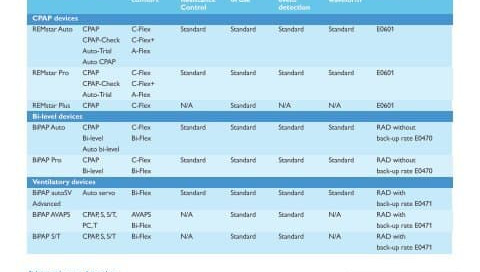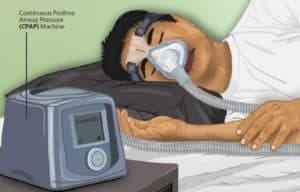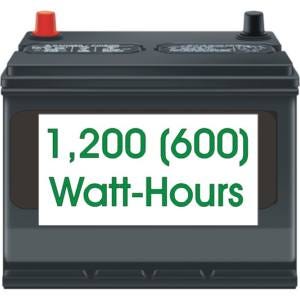How many Lithium batteries are needed to power two CPAP machines?
A quick lesson in how to calculate power costs and battery requirements
Everyone… I get questions like this one every week, and it’s a great opportunity to show you the basic math that goes into figuring out how much battery capacity is needed for common electrical devices.
The question…
Dear Mike,
Yesterday I ordered a new Lance trailer with the 190-watt solar panel on the roof and 1500-watt inverter. I plan to install lithium batteries so my wife and I can use our CPAP devices all night if we are boondocking for a few days. If we are staying in an RV park hooked up to 30-amp service, will the manufacturer’s supplied onboard converter charge the lithium batteries to 14.4 volts or just 13.6 volts? Does it matter, since the solar panel will top them off during the day? Also, can you recommend a preferred lithium battery? Thank you in advance. —Johnny
We need more information…
Dear Johnny,
Photo credit: myupchar.com, Wikimedia Commons
The only way to know for sure is to look at the spec sheet for the converter. Do you know the name and model? And be aware that you’ll probably have to change a switch on the converter to set it to lithium mode.
Also, a CPAP machine can use up to 500 Watt-hrs overnight if you use the humidifier. A 100 amp-hr lithium battery only has 1,200 watt-hrs of storage, so you could drain the battery overnight running two CPAP machines. Do you have any data on your CPAP units?
I’m guessing you’ll want 200 amp-hrs of lithium, which is 2,400 watt-hrs. That 190-watt solar panel can only provide around 800 watt-hrs per day. So that’s approximately four days to completely recharge the 200 amp-hrs of batteries from 0% to 100% State of Charge (SoC), if everything else is turned off.
Johnny responds
First, thank you for your timely reply. Our CPAP machines’ combined draw is 11 amps. So, for a 7-hour use period, that’s 77 amp-hours or 77 X 12 for 924 watt-hours drain, if my calculations are correct. So, yes, a pair of 200 ah batteries are most likely the best choice for me.
Our converter is a Progressive Dynamics 4060, which charges lithium batteries at 60 amps. UGH. Too much for a number of batteries like the SOK and Enduro 100 ah ones, as well. The Enduro Baja Series 12 V 200 ah accepts a 20-100 amp charge, has over/under charge, plus high/low temperature protection as well. So far, this is on the top of my list, but my research isn’t over. Any suggestions are welcome… Regards, Johnny
Everyone,
Did you see how the math worked? Johnny was able to determine that his two CPAP machines used a combined energy of 77 amp-hrs over a 7-hour period. That suggests a 100 amp-hr lithium battery would be nearly drained overnight, or at least down to 23 amp-hours. So he really needs at least 200 amp-hrs of lithium batteries to do this comfortably and still have enough battery charge to make coffee in the morning.
You should be aware that all modern lithium batteries are rated to be discharged down to 0% SoC (Watch for my new data on the effect of Depth of Discharge on Lithium battery longevity ). But that’s not the case with FLA (Flooded Lead Acid) or AGM (Absorbed Glass Mat) batteries, which should only be discharged down to 50% for best lifespan.
What about charging?
His 190-Watt solar panel will never be able to catch up with the power needed by the CPAP machines. So if he wants to replenish his overnight CPAP usage every day, that would require at least 300 watts of solar panels, and 400 watts would be better.
More math…
However, since I often have to combine 12-volt DC and 120-volt AC loads in my calculations, I like to get all values into watt-hours (Wh or Watt-Hrs) of energy.
To do that, simply multiply the voltage times the amps. So a 12-volt battery rated for 100 amp-hrs of storage is able to provide 12 x 100 or 1,200 watt-hrs of energy. Now we can use that number to figure out all sorts of things.
For example, a 1,200 watt-hr battery connected to a 1,000-watt generator would need at least 1.2 hours to charge (assuming 100% transfer efficiency). See that? 1,200 / 1,000 = 1.2 hours. And a 600-watt space heater would drain a 1,200 watt-hr battery in 2 hours. That’s because 1,200 watt-hrs / 600 watts = 2 hours.
This same formula can tell you things like how long a 2 kW generator would take to recharge an EV that had a 75 kWh (kilo Watt hour) battery. And the answer is 75 kWh / 2 kW = 37.5 hours. Again, that’s assuming a 100% energy transfer which doesn’t happen, so it will take even more time.
Cost analysis
Armed with this simple math, you can also determine how much this would cost if you were plugged into a home outlet. So, if you pay 20 cents per kHw of electricity at your home, and you’re running a 1,000-watt space heater, that’s 1 kWh of electricity (or 20 cents) per hour of operation. If it runs continuously for 24 hours, that’s $4.80 per day, or $144 per month (because 30 days x $4.80 per day = $144).
That’s all the calculations for now…
Get out your calculators and try this with your own electrical devices. Knowledge is power! Viva la math!
Let’s play safe out there…. Mike











Johney: "My 60 amp charger is too much for a blah blah 100 A/H......" Keep in mind that if you add 2 100 A/H batteries the charge will be split between them so each will get a max of 30 amps
Mike, it's important to understand that the bulk of a CPAP power consumption profile is in the temperature control and humidifier. If the user can do with minimal hose temperature and humidity control, the power consumption drops dramatically (70% less). Many boondockers (me included) run their CPAP's with a low temperature setting and no humidifier. Dry nose/mouth can be a problem for some, but not me. As always, YMMV.